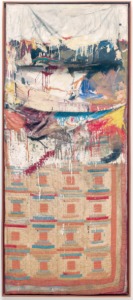
The dazzling, haunting ‘combines’ at the heart of Tate Modern’s forthcoming retrospective were part of a private game between Rauschenberg and his peers and sometime lovers, Cy Twombly and Jasper Johns.
Robert Rauschenberg’s 1954 work Untitled is an upright wooden box supported by a white, colonial-era table leg over an open stage-like enclosure in which a stuffed Dominique hen struts next to a nostalgic photograph of a tall man in a white suit. Walk around this oddly compelling array – every surface of which is covered in old pictures, newsprint and smeared paint – and you find a pair of shoes, painted white. Do they belong to the man in the portrait? Who was he? Why does this constellation of stuff trigger such an undeniable, unforgettable sense of mystery?
All the art movements that have appeared since the 1950s were anticipated by Rauschenberg and co, often in collaboration with their composer friend John Cage. Rauschenberg helped to invent conceptual art when he borrowed a drawing by Willem de Kooning and promptly erased it. His 1961 “portrait” of the gallerist Iris Clert is a telegram that simply states: “This is a portrait of Iris Clert if I say so.”
